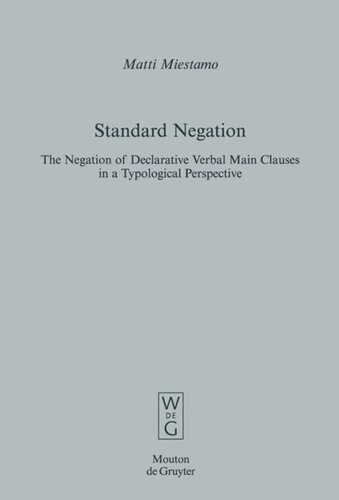

Most ebook files are in PDF format, so you can easily read them using various software such as Foxit Reader or directly on the Google Chrome browser.
Some ebook files are released by publishers in other formats such as .awz, .mobi, .epub, .fb2, etc. You may need to install specific software to read these formats on mobile/PC, such as Calibre.
Please read the tutorial at this link: https://ebookbell.com/faq
We offer FREE conversion to the popular formats you request; however, this may take some time. Therefore, right after payment, please email us, and we will try to provide the service as quickly as possible.
For some exceptional file formats or broken links (if any), please refrain from opening any disputes. Instead, email us first, and we will try to assist within a maximum of 6 hours.
EbookBell Team

0.0
0 reviewsThis book is the first cross-linguistic study of clausal negation based on an extensive and systematic language sample. Methodological issues, especially sampling, are discussed at length. Standard negation – the basic structural means languages have for negating declarative verbal main clauses – is typologized from a new perspective, paying attention to structural differences between affirmatives and negatives. In symmetric negation affirmative and negative structures show no differences except for the presence of the negative marker(s), whereas in asymmetric negation there are further structural differences, i.e. asymmetries. A distinction is made between constructional and paradigmatic asymmetry; in the former the addition of the negative marker(s) is accompanied by further structural differences in comparison to the corresponding affirmative, and in the latter the correspondences between the members of (verbal etc.) paradigms used in affirmatives and negatives are not one-to-one. Cross-cutting the constructional-paradigmatic distinction, asymmetric negation can be further divided into subtypes according to the nature of the asymmetry. Standard negation structures found in the 297 sample languages are exemplified and discussed in detail. The frequencies of the different types and some typological correlations are also examined. Functional motivations are proposed for the structural types – symmetric negatives are language-internally analogous to the linguistic structure of the affirmative and asymmetric negatives are language-externally analogous to different asymmetries between affirmation and negation on the functional level. Relevant diachronic issues are also discussed. The book is of interest to language typologists, descriptive linguists and to all linguists interested in negation.